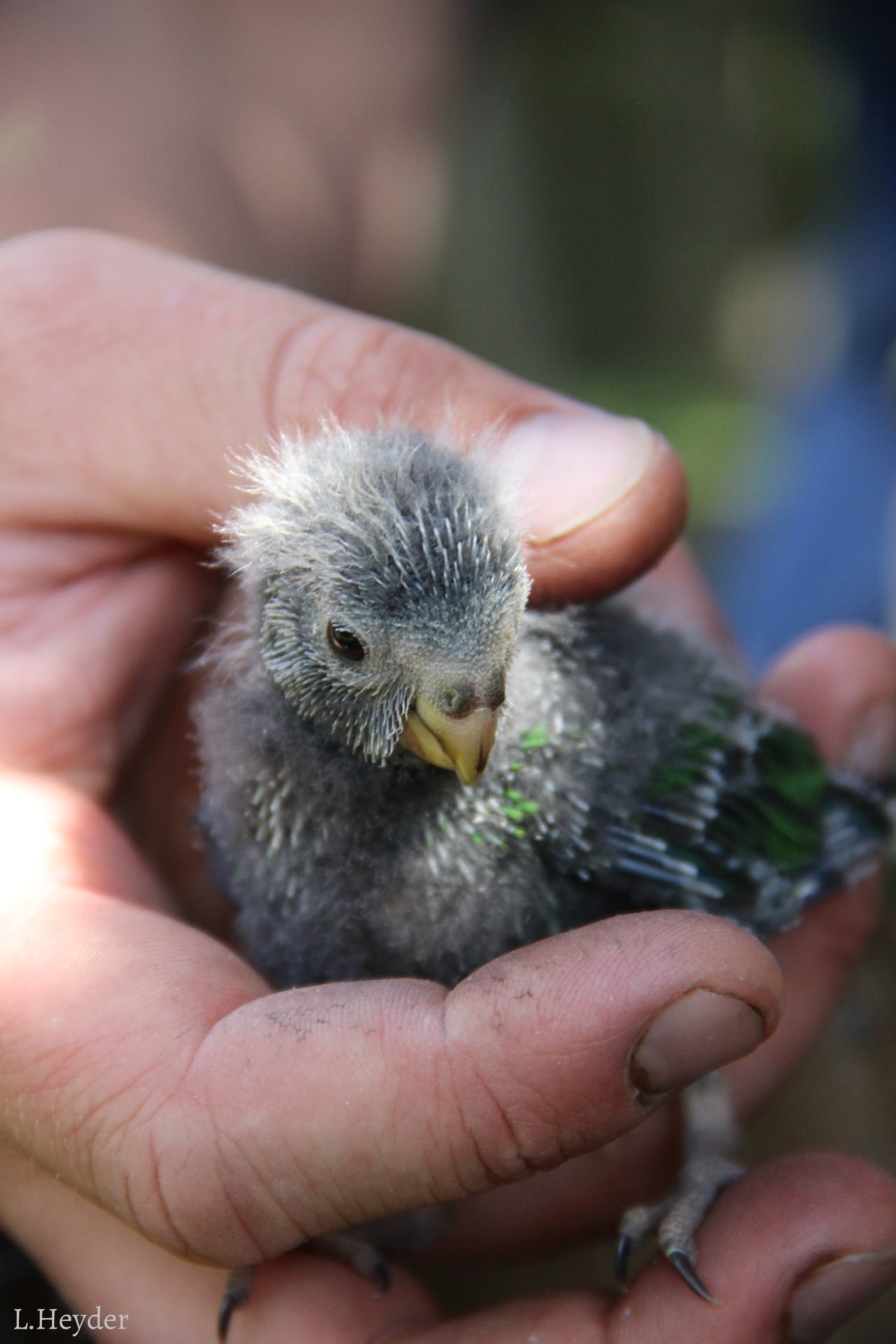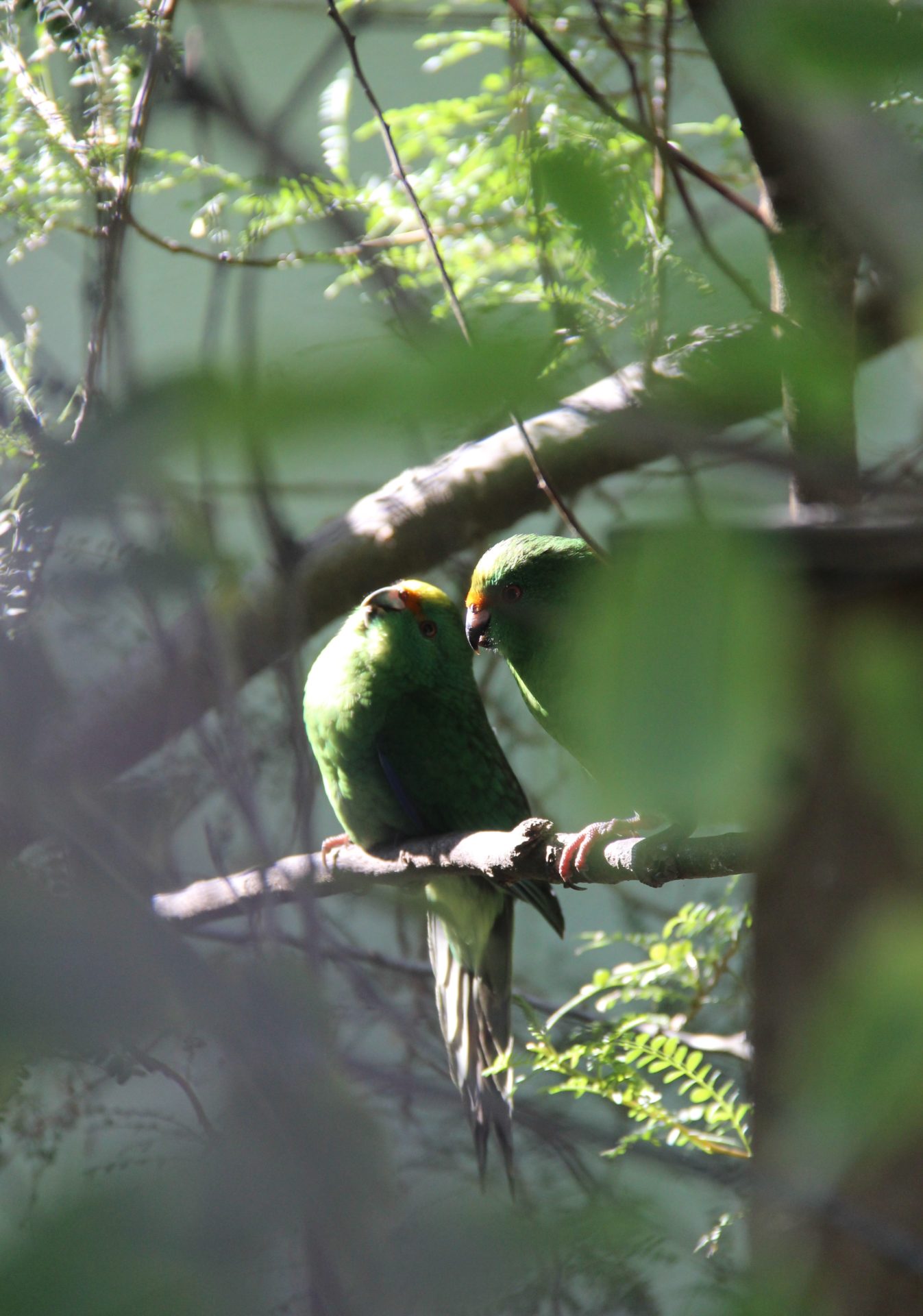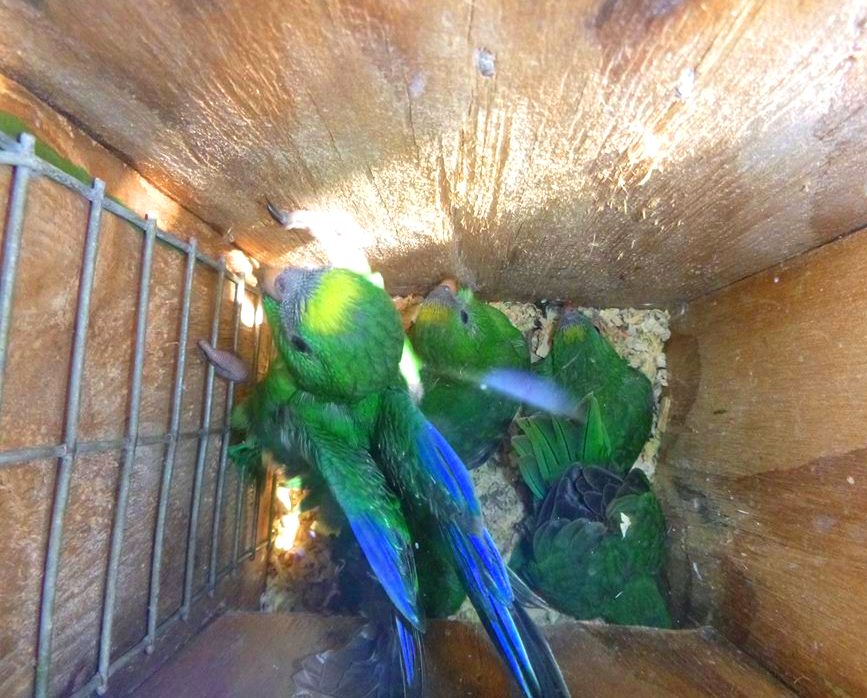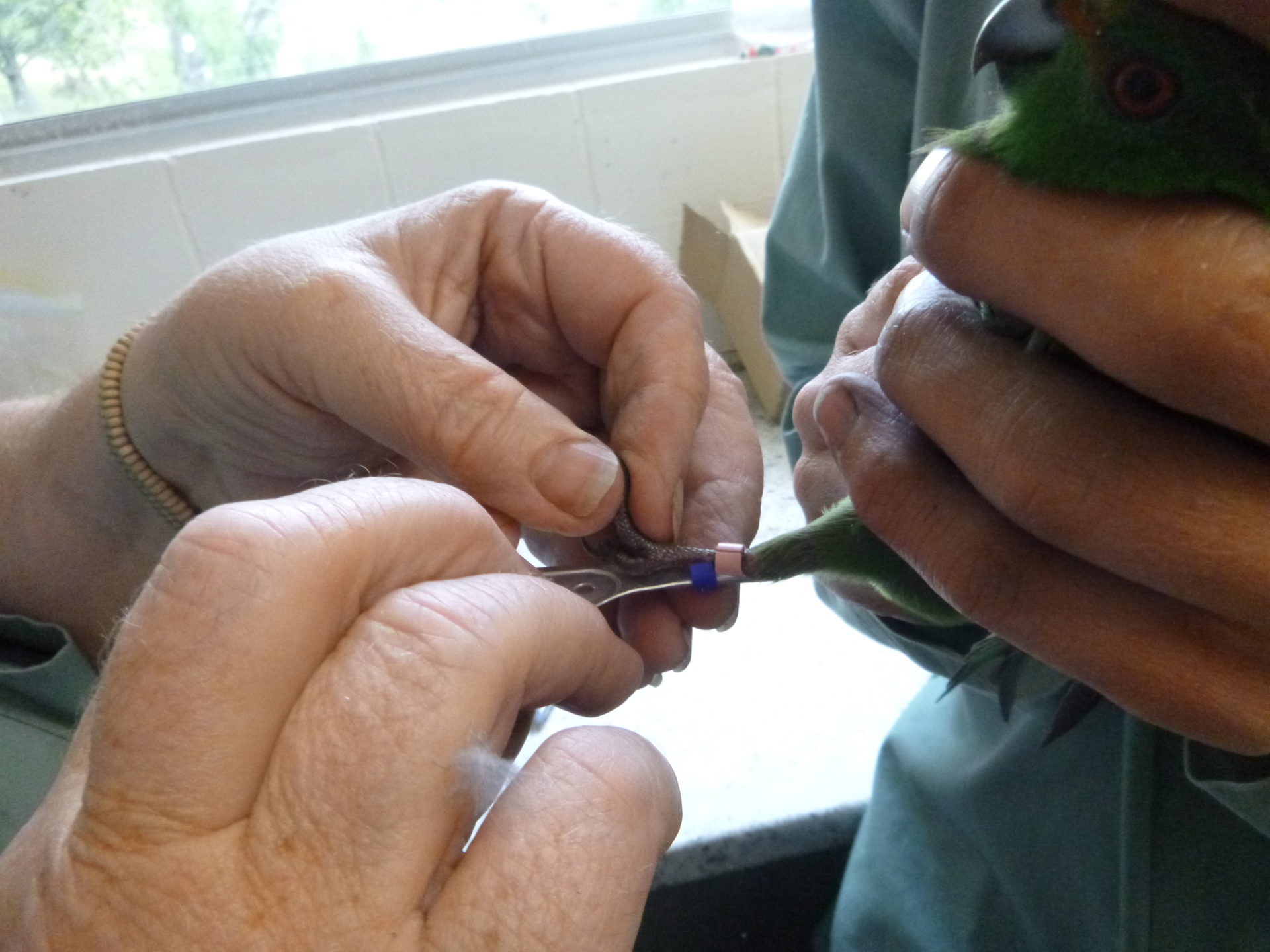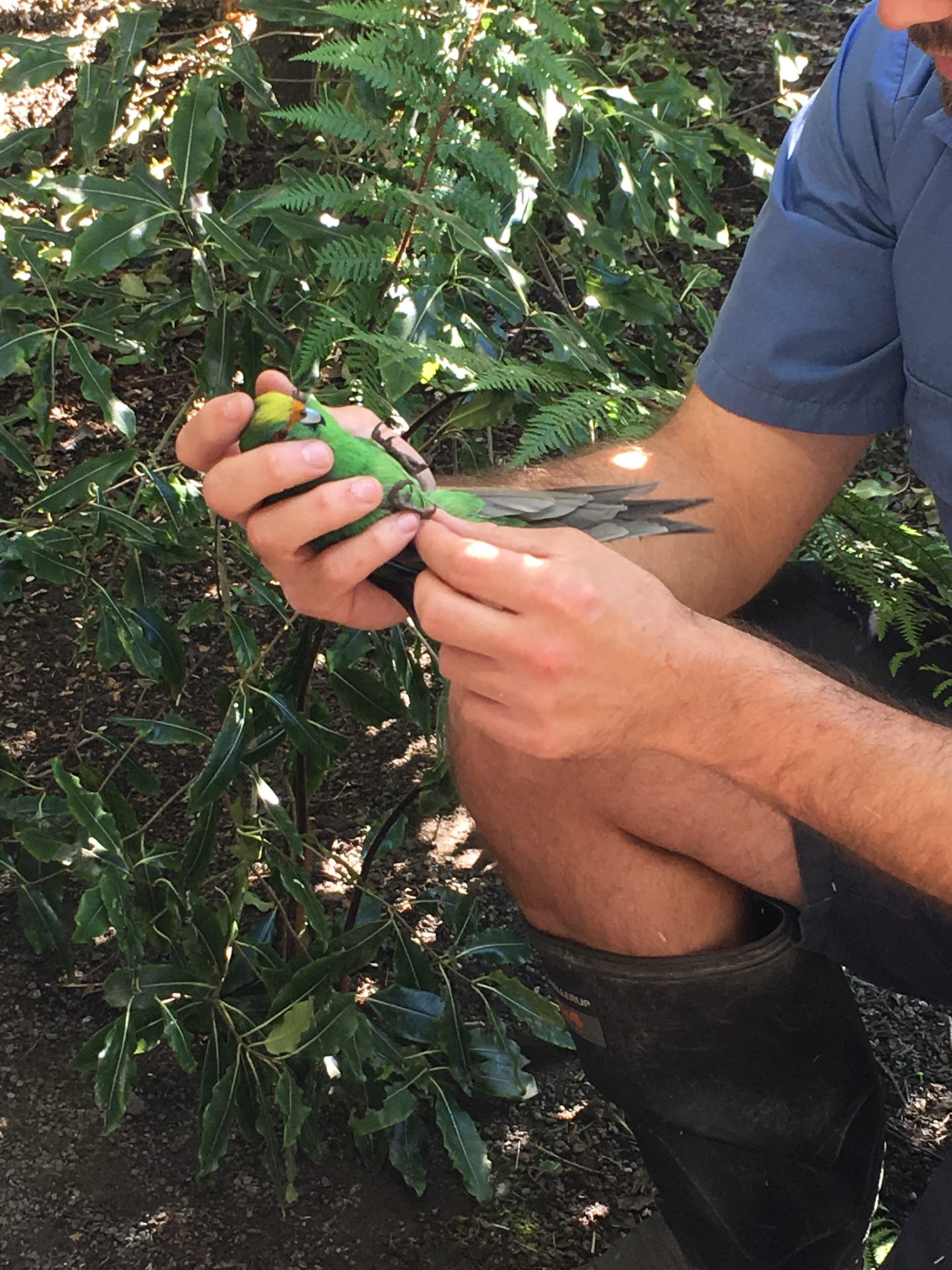Translocation and reintroduction of kākāriki karaka
The first translocation of kākāriki karaka (orange-fronted parakeet) to the Brook Waimārama Sanctuary took place on 18 and 20 November 2021; the birds were raised in captivity in Christchurch at The Isaac Conservation and Wildlife Trust. Subsequently, this was followed by additional translocations in 2022 of birds bred and raised at ISAACS and also Orana Park in Christchurch. The most recent translocation of kākāriki karaka was 24 January 2023 with a further 9 birds bred at Auckland Zoo added to the growing population of these important manu (birds) in the Sanctuary.
After a 100-year absence from the region a 2023 nationwide status report on the species prepared by the Department of Conservation has noted that the Sanctuary kākāriki population is “tracking well”. The Sanctuary survey found 170 birds; of note, only three banded birds were found during the survey. Most sightings were of unbanded birds during extensive searches in July, this resulted in a dramatic increase in the estimated size of the population. At a range of up to 214 birds, the population at the Sanctuary represents the largest group in the country. The latest population results are very positive and reinforce that the population has not just established, but is thriving, in the Sanctuary environment.
This achievement is regarded as very important to the Sanctuary Trust, staff, supporters and volunteers as it represents proof of concept.
What does this mean for us?
The reintroduction of kākāriki karaka (the orange fronted parakeet) follows the earlier release of tīeke (saddleback) into the Sanctuary in April 2021. Followed by the translocation of 44 powelliphanta (native carnivorous land snails) signal that the Department of Conservation, local iwi and others are confident that we have the necessary bio-security policies, procedures, infrastructure and technical expertise to ensure reintroduced species have the best possible chance of survival and to increase in numbers. This opens the way to further reintroductions, the Sanctuary vision is to return a number of species such as tuatara, kaka, kiwi, and others to the Sanctuary habitat.
What is a successful translocation?
Establishment is achieved when a population has become self-sustaining. Depending on the release environment and species involved, this may take several years and may require multiple follow-up translocations to ensure that the population is large enough, and has sufficient genetic diversity, for long-term stability.
There are many factors that contribute to a successful translocation, among them handling the birds with care, selecting healthy individuals, keeping the birds well fed and watered, and minimizing stress and overheating during transport and release.
Translocations of birds to the mainland is more challenging than to offshore islands. The water surrounding islands acts not only as a barrier for invasive predators, but also hinders endangered birds from leaving the safety of the islands. In contrast, due to the open nature of mainland sanctuaries, post-release dispersal away from the release site can be a challenge. The Brook Waimārama Sanctuary is unique because it is connected to the much larger Mount Richmond Forest of approximately 160,000 hectares; the possibility that the reintroduced kākāriki will disperse beyond Sanctuary and be at risk of predation is very real. It is hoped that because the Sanctuary will provide more than ample food and water that the manu (birds) will remain within the Sanctuary fence.
Once the birds are released, maintaining the biosecurity predator-free status of the Sanctuary will be essential. This includes maintaining the integrity of the fence, rapid and effective responses to breaches, ongoing monitoring to detect predator incursions and continuing regular Sanctuary-wide pest surveys. While this is already being done, there will have to be greater vigilance from now on.
The translocation process
In November the Brook Waimārama Sanctuary received 20 critically endangered kākāriki karaka (orange-fronted parakeet/OFP) that were raised at the Isaac Conservation Wildlife Trust (ICWT) in Christchurch. Until recently ICWT have been the sole captive breeding facility OFP’s. Since 2003, the Trust has bred over 600 birds and contributed significantly to the survival of this species. Multiple breeding pairs are held on site and all offspring produced are either released or retained for the captive breeding programme. In recent times, ICWT has begun to convert existing aviaries originally constructed for other species into OFP breeding aviaries. This work, alongside other captive breeding facilities joining the programme, will lead to a major increase in captive breeding capacity, resulting in more captive bred birds available for release into suitable locations.
The transfer to BWST is a significant event – it is the first time kākāriki karaka have been introduced to a sanctuary and represents a significant new site for the Kākāriki Karaka Recovery Programme.
The birds were to Nelson Airport by Air New Zealand and then helicoptered to the Sanctuary, where they were initially held in special on-site aviaries for a few days to acclimatise before their release into the wider sanctuary.
As well as the conservation significance, this transfer is culturally significant as kākāriki karaka are a taonga species and the birds are being transferred to outside of the Ngāi Tahu takiwa.
What you can do to help
The Sanctuary needs to continue to be predator-free which means high biosecurity vigilance, so we need lots of volunteer help with pest monitoring surveys, we also need donations and supporter fees to help cover our operational costs. Why not join us?
When visiting the Sanctuary it will help us if people report back to the Visitor Centre if they sight or hear kākāriki (and/or tīeke) during their walk. Birds will have different coloured leg bands and if these can be observed, without disturbing the bird, it will help us build a picture of where individual birds are within the Sanctuary. We would also welcome high-quality pictures and video footage to add to our archives.
People can help by observing the rule of not walking their dogs close to the outside of the fence of the Sanctuary.
Anyone interested in becoming a volunteer, please click here
Financial support
If you wish to make a donation or find out more about becoming a supporter or sponsor of the Sanctuary, please click here

